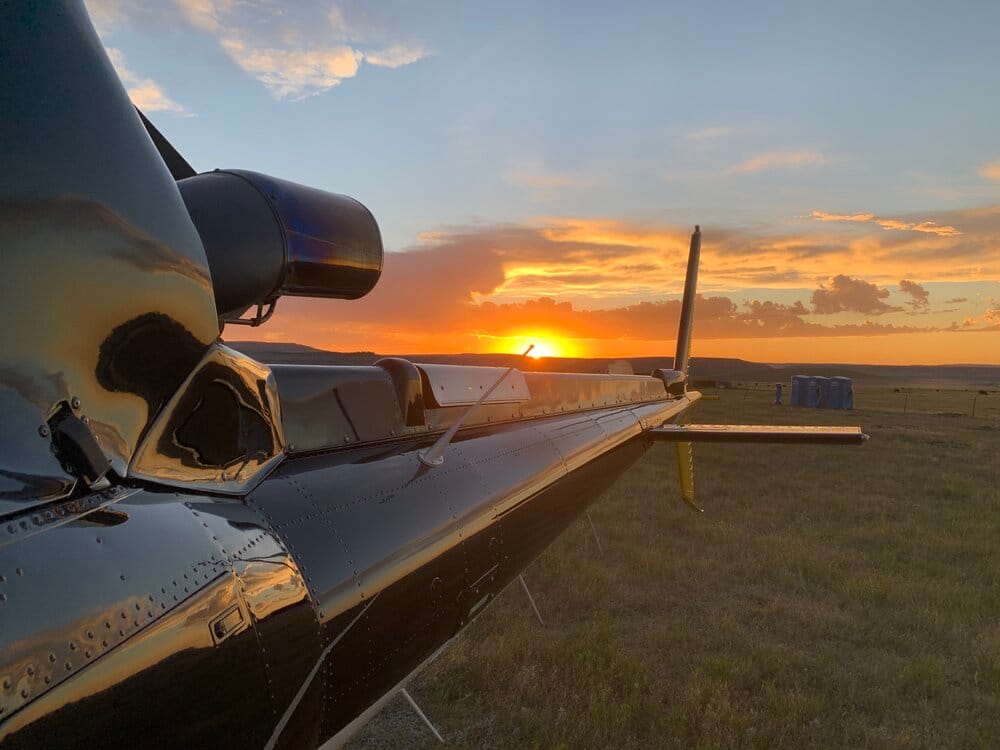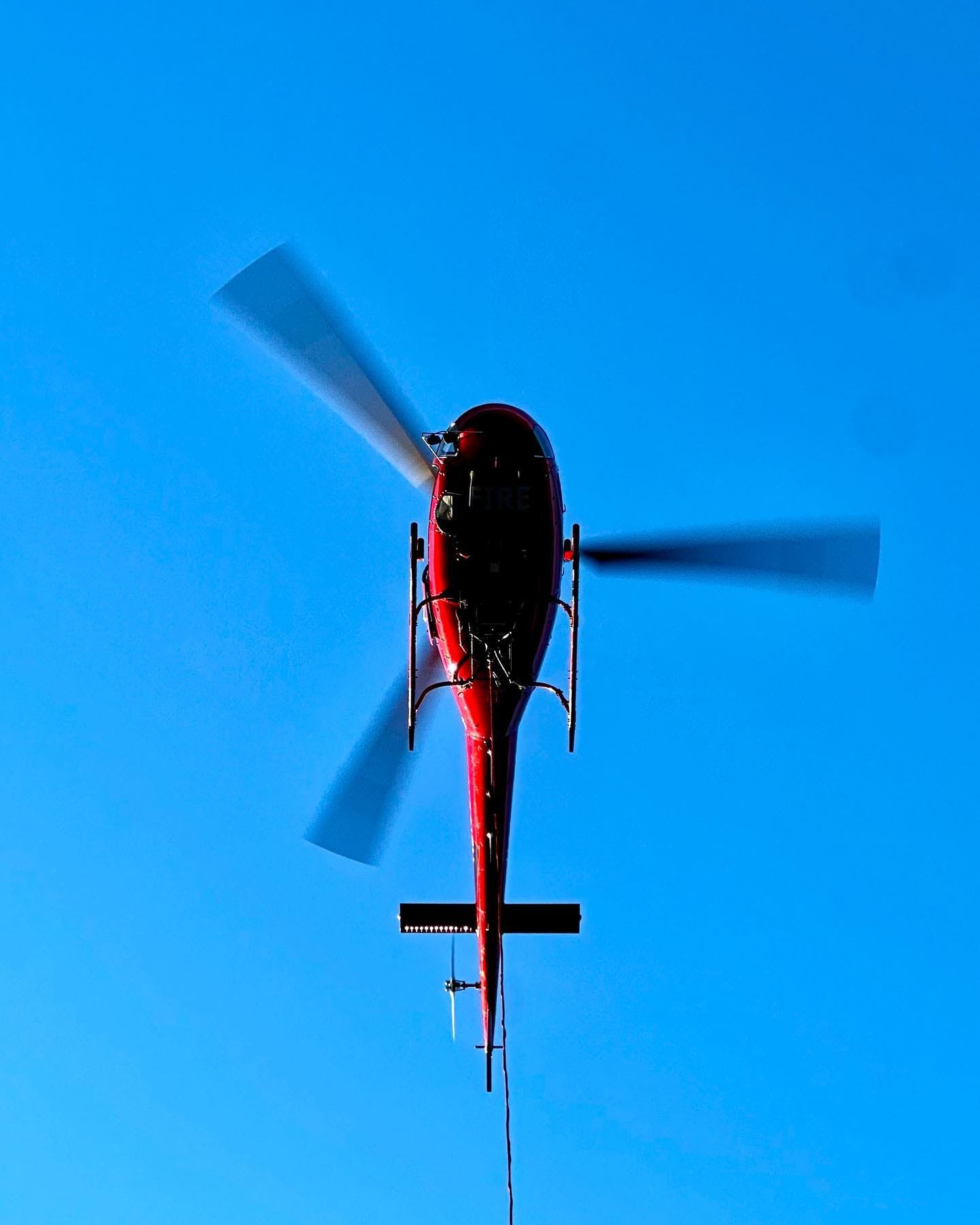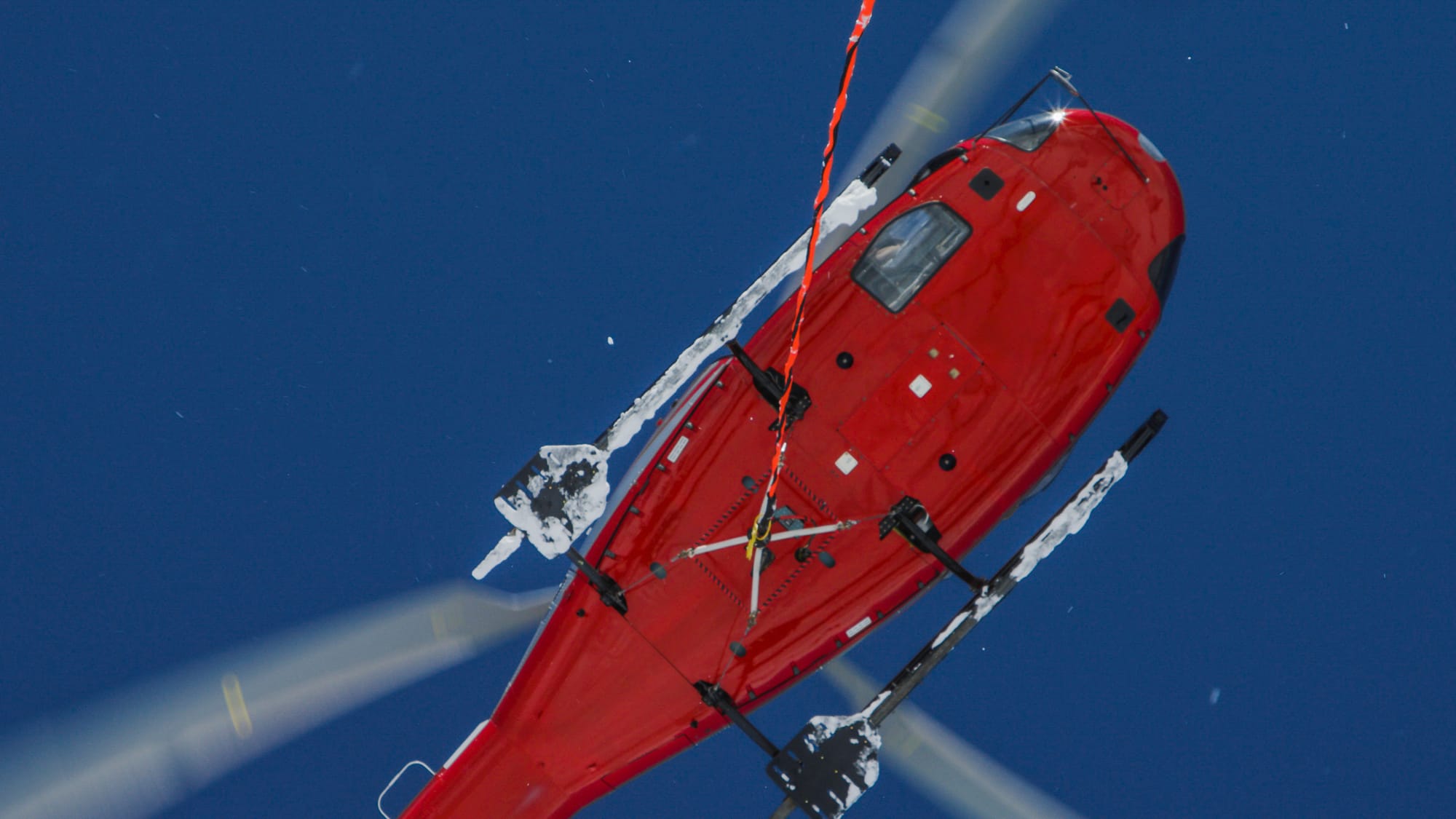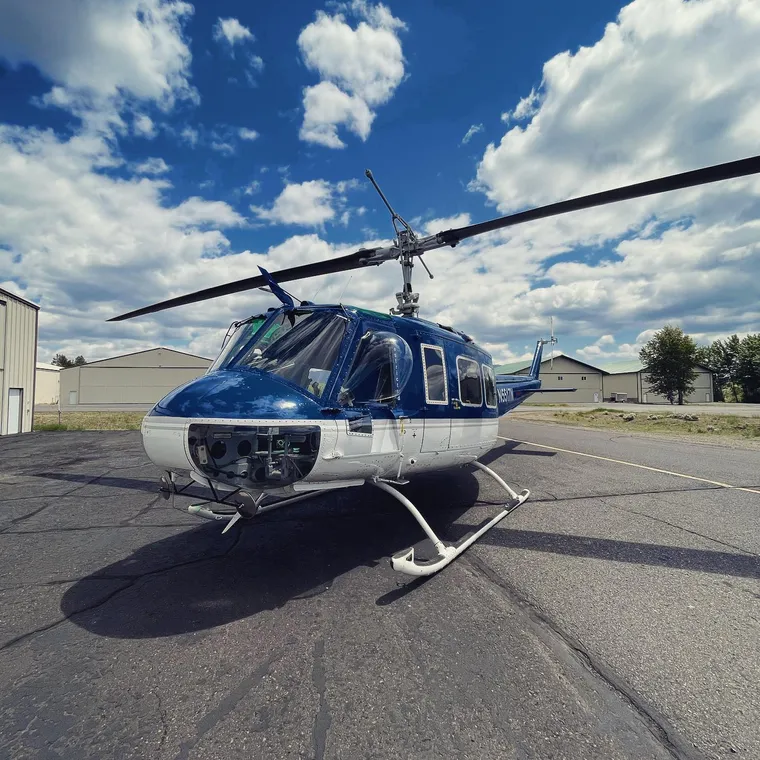Base Camp Aviation to expand its operations with sky tours and heli-skiing
Jeff Adams is one of those people who knew exactly what they wanted to do out of high school.
Unlike most, he had faith, followed through, and many years later, he is doing exactly what he loves—in those few great moments between the paperwork at least.
“Flying is really the only thing I ever wanted to do,” Adams says. “I grew up with a passion for aviation and then in my early 20s, I was finally able to sort of get into it.”
Levitating off the ground and flying around the Central Idaho mountains never gets old for Adams, even after he opened the doors to Base Camp Aviation in 2017. His small business operates out of the McCall airport and offers a wide variety of services with its fleet of five helicopters.
Most recently, Adams has begun work on an expansion of his usual operations. This exciting new venture will allow locals to explore their backcountry backyard from an entirely new viewpoint.
“We're basically going to be operating helicopter tours around McCall,” Adams says. “We're going to work with local guides to get people out hunting and fishing, and hopefully eventually doing some heli-skiing. That’s the goal, to be more of a service to our community.”

Two-In-One
McCall Heli will be something of a subsidiary business under Base Camp Aviation. The new business will be dedicated to local operations out of the McCall Airport with an emphasis on serving the community’s needs.
“I'm going to kind of split up the companies because it really is two different operations—I actually struggled with keeping them one and the same,” Adams says. “The focus for McCall Heli is to serve our community and to provide, you know, once-in-a-lifetime experiences.”
To help fill out the fleet, Base Camp Aviation acquired its most recent aircraft earlier this year—a blue and white Bell UH-1 Iroquois, nicknamed “Huey.” Bell Helicopters originally developed this model for military use, but has since manufactured several civilian models meant for transport and multipurpose utility.
“With the new operations comes applying for a permit to land in certain places where we can offer hunting, fishing, and skiing trips,” Adams says. “So, that's kind of what's on the horizon—we don't particularly offer those right at this moment, but that's the big goal for the company. Our little motto is ‘Hunt, Fish, Ski, Explore.’”
The Huey is also perfect for Base Camp Aviation’s main operations in Idaho and across state lines, including firefighting, cargo transportation, aerial surveys, game surveys and capture, predator control, aerial construction, agricultural assistance, and heli-skiing. The airframe also has a good amount of cargo space to fit passengers and equipment for tours once Adams gets that up and running.
“A lot of times our helicopters are out fighting fire or they're somewhere else in the country doing a job and we want to have one based here locally,” Adams says. “There's a lot involved with that, with insurance, funding, and all that stuff keeping us pretty busy.”
As the primary business, Base Camp Aviation handles various contracts within the western United States. For example, Adams has an established contract with a heli-skiing company based out of Jackson, Wyo.
“They contract our helicopters to go out there and fly for them,” Adams says. “They're the heli-ski company, per se. They have the operation, the guides, they book all the people—we're just there essentially to operate the helicopter.”
This relationship helped Adams and his team gain valuable experience that they’ll likely use to work with local guides as they set up their own heli-skiing operation.
With the new locally-based helicopter, McCall Heli hopes to fill that niche in Central Idaho. Yet, on top of the typical small-business red tape, Adams has many other hurdles to overcome before he and his team can begin to operate recreational tours.
“That's one of our goals that's in the works, but it’s tough,” Adams says. “We've had pretty much nothing but support from the community to do stuff like that, but we have to make sure we're keeping the community happy, and then we have to do environmental impact studies as well. We have to go through the whole permitting process—we want to make sure that we're doing it right and keeping everybody happy.”
Additionally, Adams and his team at Base Camp Aviation have met with Valley County Search and Rescue to establish a working relationship to assist as necessary with their operations.
“As I mentioned before, we want to be a service to our community,” Adams says. So we're offering our helicopter to search and rescue for zero profit. It's something that we're passionate about.”

Bottom To Top
Adams’ passion began in his childhood—it felt inherent to him, and his love of aviation only grew.
“I've always told people, I try really hard,” Adams says. “I have a huge passion for aviation. I love this industry.”
Quickly after high school, Adams found a job with a helicopter company sweeping floors, working around helicopters.
“That gave me the bug for helicopters in particular,” Adams says.
There, he worked hard and put himself in the right place at the right time.
“Flying, that’s all I ever wanted to do. That was the work that most interested me,” Adams says. “But growing up, I had always worked on things. I was always tinkering with dirt bikes and stuff. So, when the helicopters started rolling in to get ready for the fire season, I started working with the mechanics.”
Shortly thereafter, the director of maintenance offered Adams a full-time apprenticeship. After 30 months, Adams earned his Airframe and Powerplant (A and P) license, an aviation mechanic certification issued under the Federal Aviation Administration (FAA).
He worked his way up the ladder from janitor to mechanic, never losing sight of his ultimate desire to fly. To further his aviation career, Adams leveraged his hands-on experience and newfound skills as a mechanic to pay for flight hours.
“I would trade a full day of mechanic work for one hour of flight time at the end of the day,” Adams says. “I did that for a while until I earned my licenses.”
Adams ran into many challenges throughout his time learning to fly, but one of the biggest difficulties was finding a balance between feeding himself and earning flight time. Consistent flight hours are important in the process of earning a pilot’s license, and without a formal program, Adams had to find his own path.
“For a guy who's trading work to fly, that's fine for a while, but at some point, you have to make money to survive,” Adams says.
Searching for that balance, Adams spent three years earning his pilot ratings. Most students within a formal flight training program can do the same within nine months.
“Without going to a flight school full time with a curriculum, the challenge was just staying consistent and getting all my ratings as fast as I wanted to,” Adams says.
Specifically, Adams worked to earn his private rating which allowed him to fly himself and family members without compensation, his instrument rating which allowed him to do the same except guiding the helicopter only with instruments, and his commercial rating which allowed him to do all this for hire.
With such a well-rounded skill set, Adams was able to travel the world, taking on whatever jobs would come his way to get more flight time.
“I don't know how, but somehow I kind of got known for being the guy that would kind of take on any job,” Adams says. “So, I got hooked up with some other companies that needed a contract mechanic to go overseas. Mexico, Honduras, Chile, we went to Antarctica, and I did all that as a contract mechanic, and with that came a lot of flight time, just doing ferry flights.”
Eventually, Adams had enough experience and skills that he was able to find work specifically as a pilot after earning his Commercial Helicopter and Fixed Wing pilot licenses.
“Once I was marketable, I got a job doing [agricultural] work—I started spraying crops you know, went to a couple different companies, eventually I started doing longline construction work, and then got into firefighting,” Adams says. “So, I worked my way up from the bottom there, from sweeping floors.”
This finally led to Adams’ current project, Base Camp Aviation which he established after 10 years of utility helicopter experience.
“I've always kind of been an entrepreneur. I think at some point I knew I was always going to work for myself in whatever career field that I was in,” Adams says. “Once I gained enough experience, I felt comfortable running it on my own, and I felt like I could do it as good or better than other places, then I took the leap.”
Unsurprisingly, starting a business in the aviation industry is no simple task. As the forms, certifications, and paperwork began to pile up, Adams had to find a creative way to fulfill his contracts while building his business.
Firefighting contracts were Adams’ bread and butter, and during the downtimes, he would cut through some of the red tape tying down Base Camp Aviation.
“When you're on a fire, there's actually a lot of sitting, sitting around involved before you get dispatched,” Adams says. “So, I would sit there, being paid on a fire by another company, I would get on my computer, and I would write out my manuals and my procedures. I built the business as I could with my free time while I was getting paid.”
In the end, it took three years before the FAA approved Base Camp Aviation’s application.
Despite his extensive knowledge of aviation and helicopters, Adams worked hard throughout his career to stay up to date with the latest education about the systems and various helicopters available for flights.
“That's a bit challenging when you're hopping from one airframe to another and trying to keep fresh on emergency procedures and everything,” Adams says.
Additionally, Adams has worked hard to avoid complacency. As with many technical and dangerous fields, while the risk may be high, the actual danger stems from human error.
“We all, as pilots, get comfortable with certain aircraft and their surroundings—it's very easy to become complacent,” Adams says. “So, I try to keep that in mind. That's why we have systems and checklists and all the things that pilots do. It's there for a reason, and it is to counteract complacency.”

Important Work
After a few hours of traveling, digging, and measuring, Studley and Halcom take lunch break and wonder where the time went.
“It's so easy to spend over an hour in a hole, testing the snow, and being like, ‘oh my gosh, I haven't eaten yet and it’s two or three o'clock, no wonder I'm hungry,’” Halcom says with a laugh.
Each observation could consist of several different tests to determine the overall stability of the snowpack. Most commonly, PAC forecasters use the compression test, extended column test, and propagation saw test in conjunction with each other, as defined by the American Avalanche Association.
They record every detail about the snowpack: how deep the weak layer is, how it reacts to each test, which way the wind is blowing, and any other weather observations that may impact the forecast.
“Usually we're digging snow pits pretty frequently and observing the different layers in the snowpack and how they interact with one another,” Studley says. “Then what we do is we compile that into the following day’s avalanche forecast which we write early in the morning before it goes out on the website.”
Studley and Halcom collect enough data for three reports a week, every week of the ski season. On field days, they’re out for upwards of 10 hours between driving to the trailhead, snowmobiling through the woods, skiing to a test slope, digging, recording, rinsing, and repeating until they head home.
“It's pretty easy to get out there and get a full day's work,” Halcom says. “We're struggling all the time to not have too long of days, but we just have a lot to do.”
Despite the hours, it’s hard to beat the views while they work. As Studley and Halcom wrap up their lunch, they take a deep breath of dry piney air and enjoy the beauty of Idaho’s West Central Mountains.
“It can be like a lot of other jobs that have their challenges and stresses, but at the end of the day, I'm a skier at heart. So, being able to travel into these more remote areas, ski some really cool terrain, and share what I learn as part of a public-safety effort, it’s rewarding. But we spend maybe like, 3 percent of our time backcountry skiing,” Studley says with a laugh.
Their work is invaluable in a community of outdoor enthusiasts, especially in a place where the biggest draw is access to adventure. Anybody can rent a snowmobile for the weekend, grab a snowbike, or take a day trip out of bounds. So, organizations like the PAC are more important than ever when it comes to avalanche awareness and education.
Once Studley and Halcom come down from the mountains, they also work in the community as educators. They recommend any newcomers to the sport attend avalanche safety classes and take a few trips with a guide or a mentor. There’s plenty to learn in a classroom, but first-hand experience in the backcountry can sometimes be the best education.
“You just don't know until you've had a few years of experience after having some education,” Halcom says. “You don't really understand the gravity of it.”
Studley adds that even the most basic avalanche rescue class can provide a lot of perspective.
“It's much more affordable than a Level 1 class—which I also recommend,” Studley says. “But rescue is one of the most important skills you can develop right away, and it really helps people understand the gravity of what they're getting themselves into. Once you understand what it takes to dig out a buried person, you can start to understand the consequences a lot more.”
At one of the mid-season educational events, Studley listens to a guest speaker from the Silverton Avalanche School. He looks around the patio at Salmon River Brewery and sees all the outdoor industry people learning, enjoying a few brews, and looking forward to another day outside.
“To have all these people in the community with loads of experience in the backcountry, it's humbling,” Studley says. “For me to be in this role, to gather this information and put it out to the public, and then receive that feedback too from the community, to hear that they appreciate what we're doing and they appreciate our service. Yeah, I'd say it's humbling.”




